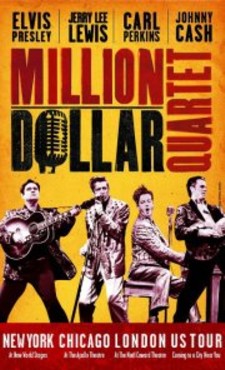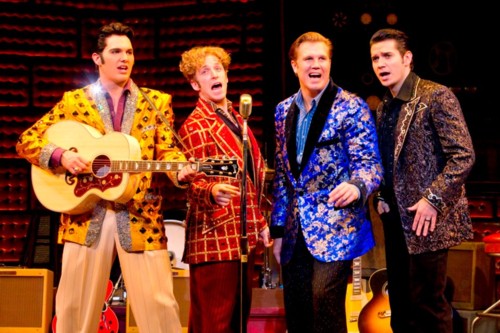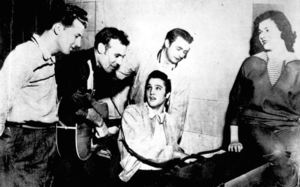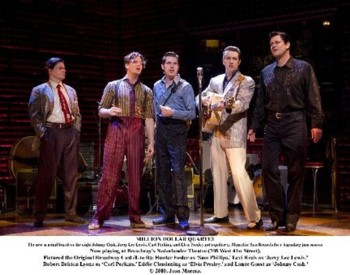The "Art of making "Million Dollar Quartet" sing on stage

|
The hit musical, ‘Million Dollar Quartet,’ spins stories out of one magical, unplanned night when a young Elvis Presley, Johnny Cash, Jerry Lee Lewis and Carl Perkins came together in a Memphis recording studio to jam.
Before The Fab Four, became "Featuring" became the most ubiquitous name on a hip-hop music file, there was the Million Dollar Quartet. One December day in 1956, four people just happened to come together in a Sun Records recording studio in Memphis, Tenn. Not just any people. The lineup boasted Elvis Presley, Johnny Cash, Jerry Lee Lewis and Carl Perkins. |
 |
No one really knew history was being made in that small recording studio, with the possible exception of visionary Sam Phillips, who founded Sun Records and who was responsible for launching these gentlemen’s careers. Phillips had the good sense to roll tape and a whole lotta jamming went down that night before the men went on to their individual careers and resulting milestones and mishaps.
This monumental meeting, never repeated — although Perkins would spend a decade in Cash’s touring band from 1965 to 1975 — is reimagined in Million Dollar Quartet, which opens Tuesday at the Adrienne Arsht Center for the Performing Arts. The Broadway version of the show, with a different cast of musicians, won a 2010 Tony for Levi Kreis as a featured actor for his role as Lewis. The show was nominated for two others, Best Musical and Colin Escott and Floyd Mutrux for Best Book.
“What made the Million Dollar Quartet great is in the way it was unplanned,” England-born Escott, 62, said in a telephone interview. Before co-writing the musical, Escott worked with Sun Records in the early ’70s to repackage the music for subsequent record companies and wrote a book, Good Rockin’ Tonight: Sun Records and the Birth of Rock ’n’ Roll (St. Martin’s Griffin; $18.99).
Visit the official Million Dollar Quartet site
“These days, superstar jam sessions are midwifed by promoters, by managers, by record companies, whatever. There’s a forced air about them. But the original Million Dollar Quartet was unplanned. Elvis walked in on Carl Perkins, and Jerry Lee was there as a session pianist who had arrived in Memphis about this point.
Sam Phillips, who owned Sun Records, thought this was one for the ages so he called Cash to come down and for a reporter to come with a photographer. What we did with the show was to kind of telescope 18 months of Sun Records history into that one night.
What happens in our show isn’t what happened that night,” Escott said.
If Perkins’ name sounds less familiar than the others, the rockabilly guitarist/songwriter’s influence on the sound of rock ‘n’ roll was significant.
He’s the man whose 1956 Billboard No. 2 hit, Blue Suede Shoes, simultaneously wore holes on the pop charts along with a Top 20 Presley cover. Paul McCartney “got it,” too, when he had Perkins play guitar and sing on Get It, a little charmer tucked away on side two of his last No. 1 album, Tug of War, in 1982. |
 |
Dramatic elements: Some of the conflict built into Million Dollar Quartet revolves around Perkins’ frustration that Presley had achieved favored son status, to the point he felt The King “stole” his recording of Blue Suede Shoes. The song is the first to be featured in the musical. The drama allowed actor/musician Lee Ferris, who plays Perkins in this production, some leeway to tell a meatier story with his character.
“There’s a nice arc for Carl to explore and for me to work on my acting chops,” Ferris, 30, said. “I usually have more freedom playing Carl because of the lack of iconic nature compared to Johnny Cash and Elvis, specifically.”
Cody Slaughter (pictured above top), 20, the show’s Elvis, relishes the scripted banter and how it fuels the off-stage chemistry between the cast members.
“You’ve got Jerry Lee, he kind of speaks when he shouldn’t speak, the goofball, like a little punk. Then you’ve got Carl, who in real life was a pretty bad dude, a rough guy, and he’s kind of like that in the show. He’s upset with me in the show because I sing his Blue Suede song that he wrote. Me and Johnny, we’re pretty happy. I’ve made it and Johnny’s making it. We never had no trouble. Elvis was cool with pretty much everybody. Elvis was the golden child.”
In addition to having to act, each man had to play his own instrument and perform the music authentically, much in the way the original quartet played their parts in Memphis. For Slaughter, who lives in the small town of Harrison, Ark, the music was the selling point. Million Dollar Quartet is his first role in a production of this caliber. Getting the Elvis part down was easy as both were Southern boys, bred on country and gospel music.
“I just knew I had to get inside Elvis’ head and bring his feelings to the stage,” he said.
“The show does that. I knew going in this had to be more than impersonation. I’m a huge Elvis fan, comes naturally for me. We’re all playing the music which makes it even that much more real.” Derek Keeling, the show’s Johnny Cash, laughs when he notes that he plays the Man in Black’s distinctive chunka-chunka-chunka rhythms so hard on the guitar on songs like Folsom Prison Blues, I Walk the Line and (Ghost) Riders in the Sky the realism requires fast-thinking and improvisation. The stage might be littered with guitar picks, busted strings and pennies (to adjust mikes) after any given night.
“A lot of people don’t know it’s real. If I break a string, I have to play around it, I’ve changed about 20 strings. I think I’m the only guy who breaks strings during the show,” Keeling said.

Stirring memories: Of the Million Dollar Quartet, only Lewis, 76, is still alive. When Cash died in Sept. 2003 he followed the deaths of Presley in 1977 and Perkins in 1998. Sam Phillips died a few months before Cash. Sometimes the realism can be too much for surviving family members. Rosanne Cash, 56, Johnny’s first-born who was 18 months old when these sessions originally happened, couldn’t bring herself to see Million Dollar Quartet when it played on Broadway near her Chelsea home.
“I didn’t see it, but I did hear the young man, Lance [Guest,] who portrayed my dad and thought him very talented. I just can’t go to these things about my dad. There are thousands and they all just remind me he’s gone.”
For Keeling, 31, who has assumed the touring role after studying Cash videos and with whom he feels a musical and spiritual kinship — like Cash did, Keeling vows to use his vocal gift to praise God in song — Rosanne Cash’s comment is heartening.
“That’s one of the best things I hear,” he said. “A lot of people close their eyes and feel they were back there and I’m grateful for that. It’s a way to recapture their youth and the times they had. The way to do it is to do the music as it was intended to be, not bring your artistry to it. If you bring too much of yourself into it, you lose some of the magic of Johnny.”
This accent on realism, without rote impersonation, proved a particular challenge in the casting process. The actors had to learn a script but function foremost as a band and have chemistry together that can’t be manufactured.
“That’s what is hard about this show,” said veteran musical director Eric Schaeffer ( Sunset Boulevard, Showboat, Putting It Together) from his Washington, D.C. home. “We needed to find musicians who can act but have characteristics of these four to five iconic men. Other Broadway shows can get slicked up. This music is back to the heart and soul of what it was. They are playing the original licks these guys played.”
From its inception in 2001, when Mutrux, director of the 1978 movie, American Hot Wax, called Escott out of the blue with an idea for MDQ, realism mattered. “
Instead of getting imitators, we were getting someone who could channel the essence of what those characters were about. No overdubbing. You couldn’t do a backing track one day and vocals the next and Auto-Tune. That’s the kind of immediacy we wanted to recreate,” Escott said. |
 |
New directions: Schaeffer, 48, had done so many Sondheim musicals he knew his way around those. But the art of making art out of Million Dollar Quartet called for a whole new approach in his directing style.
“Every musical you do is difficult but one thing that is the same is the rehearsal period — 10 to 6,” he said. “This show’s musical director, Chuck Mead, said ‘I don’t know if that’s going to work. These guys are musicians, rock and rollers. They are not ready to go at 10 in the morning.’
“I have to rethink this. I rehearsed this show unlike any other show I rehearsed. The first week, we do nothing but create the music. We’d rehearse six hours straight, but later in the day, free and open.” A regimented schedule would stifle creativity, he felt.
“It was fascinating to let the reins down a bit,” Schaeffer said.
For Martin Kaye, 27, the self-proclaimed rebel in the group, this loose rehearsal style fit perfectly with his plans to capture a young, raw Jerry Lee Lewis.

“The first day of rehearsal we gelled on the first song. It was incredible to find four guys who gel so well the way we did. We became a family and it’s been a great experience to learn from each other and respond together,” he said.
The Manchester-born Kaye loved Lewis’ storied scrappiness. “He gets put in his place and he doesn’t care. He keeps pushing people’s buttons,” he said. “I’m a rebel in my life a little bit. My brother is now an accountant and went to university and followed the traditional path — unlike me. I dropped out of university after doing languages for a year, went off and did music. I wore mismatched socks and didn’t want to conform. I didn’t have an answer, it was just about living a life you want to live, not caring what people think.”
From its first staged production, at Seaside Music Theater in Daytona Beach in 2006 to the Tony Awards and the road, one constant remains: the songs’ enduring reach.
That’s All Right. Peace in the Valley. Hound Dog. Sixteen Tons. Whole Lotta Shakin’ Goin’ On.
“I think it was the authenticity and honesty of it,” Schaeffer said of the ’50s rockabilly music’s lasting appeal. “There was nothing more than what it was. They are simple stories and ideas. Something we don’t have today. I say less is more and that’s the kind of thing this is. They don’t write like this anymore.” (Article, Source: Howard Cohen, Miami Herald, Dec 24, 2011)
Visit the official Million Dollar Quartet site
Copyright the Elvis Information Network.
Elvis Presley, Elvis and Graceland are trademarks of Elvis Presley Enterprises.
The Elvis Information Network has been running since 1986 and is an EPE officially recognised Elvis fan club.
.
. |











